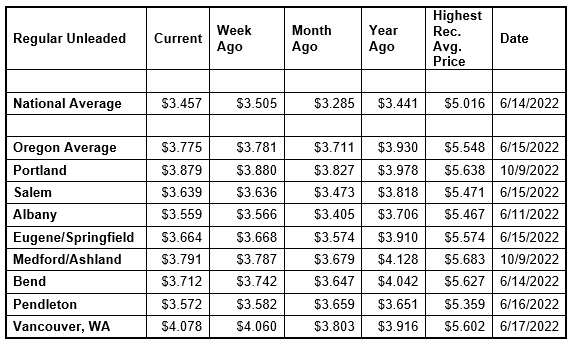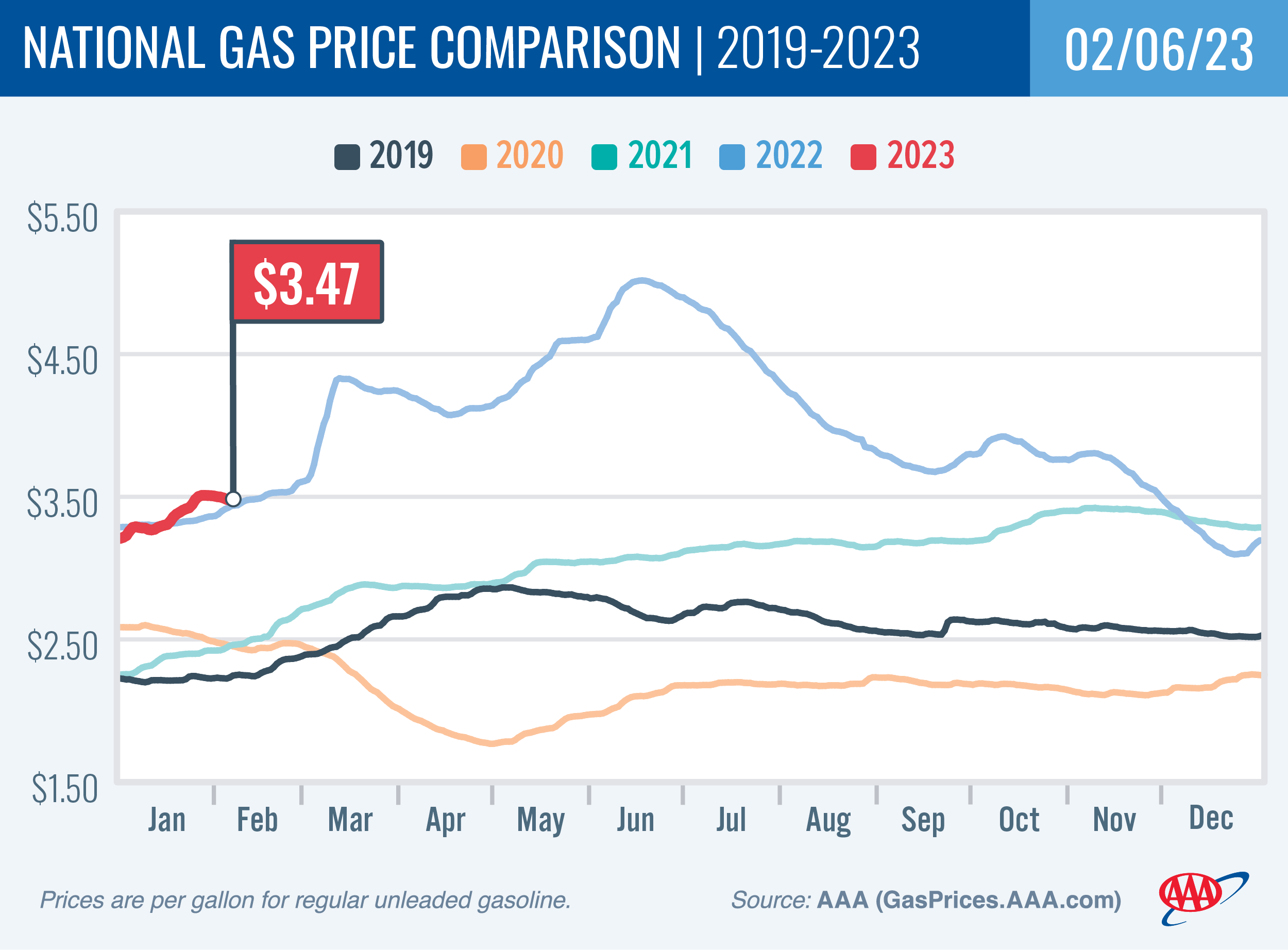PORTLAND, Ore., – Pump prices are edging lower in most states including Oregon. Last week’s decision by OPEC+ to maintain current production levels and not make any cuts led to lower oil prices. But Friday’s positive U.S. jobs report could have the opposite effect. If recession fears ease, a healthier global economy could lead to more demand for oil and higher prices. For the week, the national average for regular unleaded drops a nickel to $3.46. The Oregon average slips one-half cent to $3.78.

Friday’s U.S. jobs data report shows 517,000 jobs added in January, dropping the unemployment rate to a 54-year low of 3.4%. Crude oil prices tend to rise in response to positive economic news as countries with growing economies tend to consume more oil than countries with shrinking economies. Another driver of crude oil prices is China’s recovery after the easing of strict COVID-19 restrictions.
Crude oil is trading around $77 today compared to $79 a week ago. In January, West Texas Intermediate ranged between about $73 and $82 bbl. and was $79 a year ago. Crude reached recent highs of $123.70 on March 8, 2022, and $122.11 per barrel on June 8, 2022. The all-time high for WTI crude oil is $147.27 in July 2008.
Crude prices tend to increase when geo-political events have the potential to disrupt supply. Crude prices rose dramatically leading up to and in the first few months of Russia’s invasion of Ukraine. Russia is one of the world’s top oil producers and its involvement in a war causes market volatility, and sanctions imposed on Russia by the U.S. and other western nations resulted in tighter global oil supplies. Oil supplies were already tight around the world as demand for oil increased as pandemic restrictions eased.
Crude oil is the main ingredient in gasoline and diesel, so pump prices are impacted by crude prices on the global markets. On average, about 56% of what we pay for in a gallon of gasoline is for the price of crude oil, 20% is refining, 11% distribution and marketing, and 14% are taxes, according to the U.S. Energy Information Administration.
Demand for gasoline in the U.S. rose from 8.14 million to 8.49 million b/d last week. This compares to 8.23 million b/d a year ago. Meanwhile, total domestic gasoline stocks increased by 2.6 million bbl to 234.6 million bbl. Despite rising gas demand, total supply growth has helped limit pump price increases.
Quick stats
Oregon is one of 43 states and the District of Columbia with lower prices week-over-week. Delaware (-15 cents) and Ohio (-13 cents) have the largest weekly drops. Utah (+21 cents) and Idaho (+12 cents) have the largest weekly jumps.
Hawaii ($4.92) is the state with the most expensive gas in the nation for the 11th week in a row. California ($4.62) is second, Washington ($4.13) is third, and Nevada ($4.05) is fourth. These are the only four states with averages at or above $4 a gallon. This week 46 states and the District of Columbia have averages in the $3-range. No states have averages below $3 a gallon.
The cheapest gas in the nation is in Texas ($3.07) and Mississippi ($3.11). For the 108th week in a row, no state has an average below $2 a gallon.
The difference between the most expensive and least expensive states is $1.85 this week compared to $1.81 last week.
Oregon is one of 48 states and the District of Columbia with higher prices now than a month ago. The national average is 17 cents more and the Oregon average is six cents more than a month ago. Oregon has the seventh-smallest monthly increase in the nation. Colorado (+85 cents) and Georgia (+50 cents) have the largest monthly gains. Hawaii (-10 cents) and Indiana (-1 cent) are the only states with monthly declines.
Oregon is one of 17 states and the District of Columbia with lower prices now than a year ago. The national average is two cents more and the Oregon average is 16 cents less than a year ago. This is the third-largest yearly drop in the nation. Connecticut (-23 cents) has the largest year-over-year decline. Colorado (+61 cents) and Hawaii (+51 cents) have the biggest year-over-year jumps. The averages in Alaska and Wisconsin are flat year-over-year.
West Coast
The West Coast region continues to have the most expensive pump prices in the nation with six of the seven states in the top 10. This is typical for the West Coast as this region tends to consistently have fairly tight supplies, consuming about as much gasoline as is produced. In addition, this region is located relatively far from parts of the country where oil drilling, production and refining occurs, so transportation costs are higher. And environmental programs in this region add to the cost of production, storage and distribution.
| Rank | Region | Price on 2/7/23 | ||
| 1 | Hawaii | $4.92 | ||
| 2 | California | $4.62 | ||
| 3 | Washington | $4.13 | ||
| 4 | Nevada | $4.05 | ||
| 5 | Colorado | $3.93 | ||
| 6 | Alaska | $3.78 | ||
| 7 | Oregon | $3.78 | ||
| 8 | Pennsylvania | $3.76 | ||
| 9 | Utah | $3.70 | ||
| 10 | Idaho | $3.62 |
As mentioned above, Hawaii is the most expensive state in the nation, with California, Washington, Nevada, Colorado, Alaska, and Oregon rounding out the top seven. Arizona is 16th. Oregon is seventh for the second week in a row.
All seven states in the West Coast region are seeing small to moderate weekly changes. California (+6 cents) and Nevada (+6 cents) have the largest increases in the region. Arizona (-5 cents) and Arizona (-2 cents) have the largest decreases.
The refinery utilization rate on the West Coast fell from 79.2% to 73.0% for the week ending January 27. This rate has ranged between about 73% to 92% in the last year.
According to EIA’s latest weekly report, total gas stocks in the region decreased from 34.04 million bbl. to 33.18 million bbl.
Oil market dynamics
Crude prices fell last week amid ongoing market concerns that if a recession occurs this year, crude demand and prices would likely decline. Additionally, crude prices dropped after the EIA reported that total commercial stocks increased by 4.2 million bbl to 452.7 million bbl.
At the close of Friday’s formal trading session, WTI decreased by $2.49 to settle at $73.39. At the close of Monday’s formal trading session, WTI added 72 cents to close at $74.11. Today crude is trading around $77, compared to $79 a week ago. Crude prices are about $18 less than a year ago.
Drivers can find current gas prices along their route with the free AAA Mobile app for iPhone, iPad and Android. The app can also be used to map a route, find discounts, book a hotel and access AAA roadside assistance. Learn more at AAA.com/mobile.

Diesel
For the week, the national average falls six cents to $4.61 a gallon. The record high is $5.816 set on June 19, 2022. The Oregon average dips a penny to $4.78. The record high is $6.47 set on July 3, 2022. A year ago the national average for diesel was $3.81 and the Oregon average was $4.16.
Find current fuel prices at GasPrices.AAA.com.
AAA news releases, high resolution images, broadcast-quality video, fact sheets and podcasts are available on the AAA NewsRoom at NewsRoom.AAA.com.
Find local news releases at https://oregon.aaa.com/community/media/media-contacts.html

